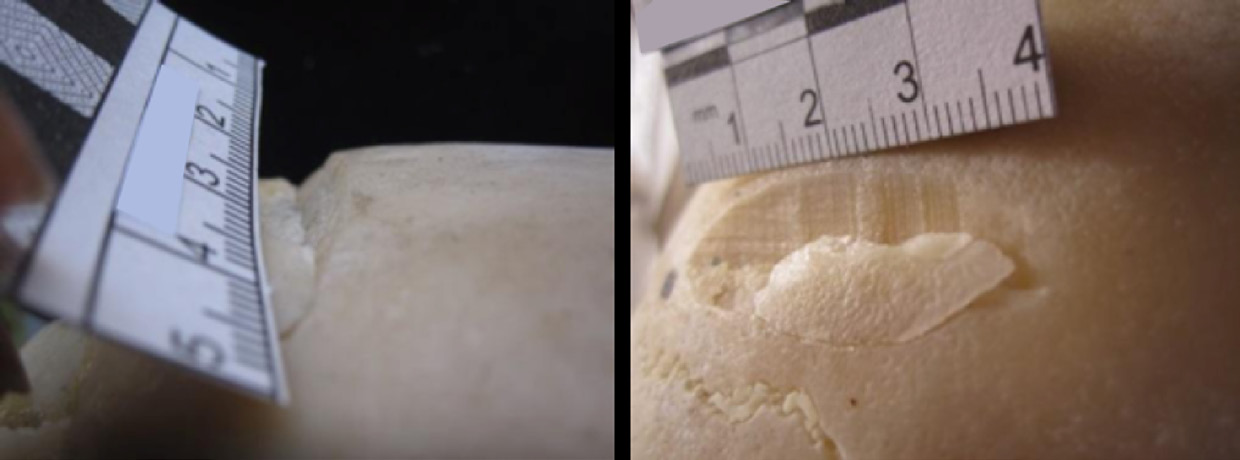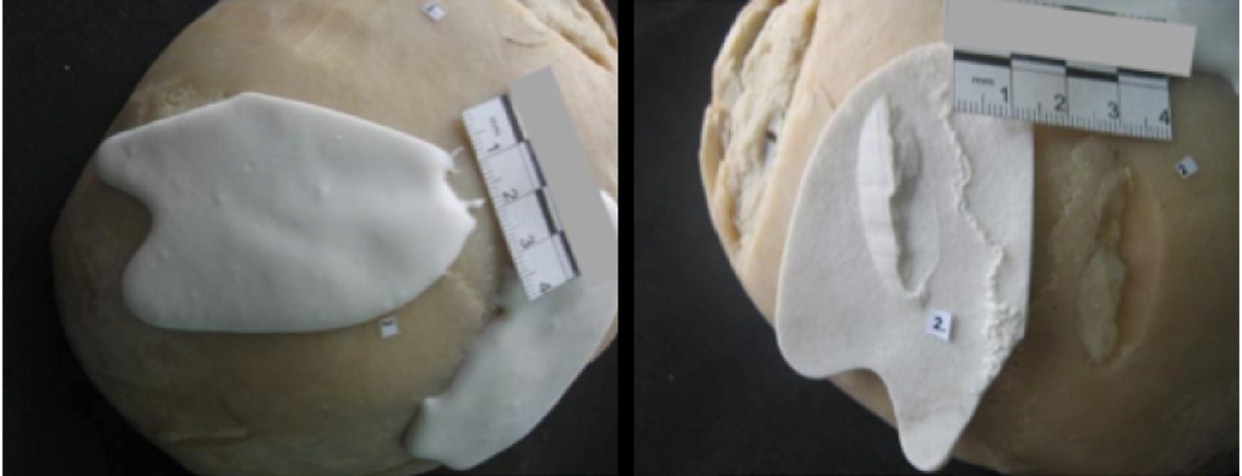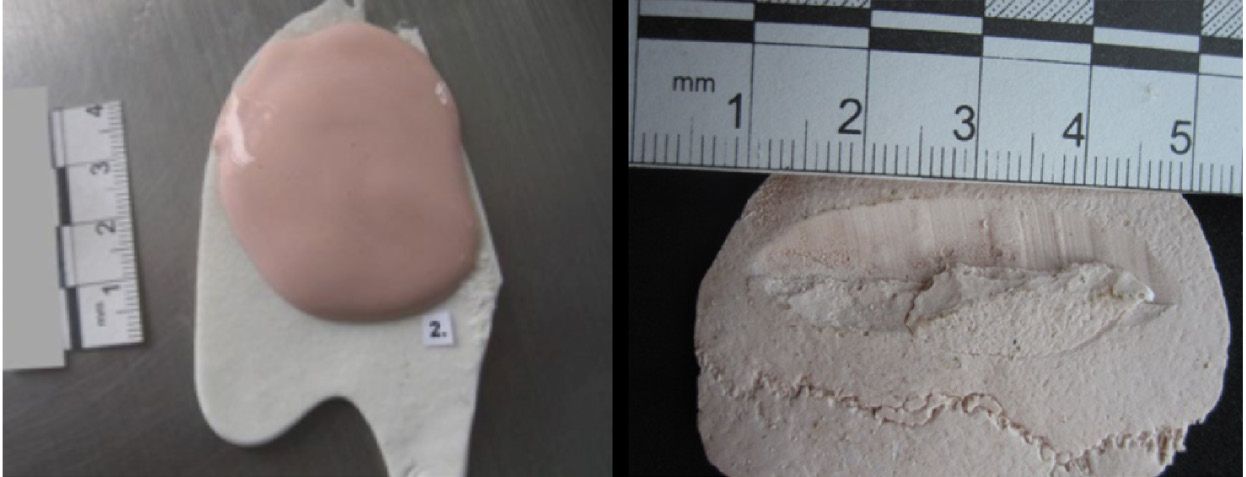USE OF DENTAL IMPRESSION MATERIALS IN THE ANALYSIS OF TOOL MARKS TO IDENTIFY CAUSAL ELEMENTS
National Institute of Legal Medicine and Forensic Sciences, Special Edition
Edna Marina Buitrago Suárez
Forensic Odontologist.
National Institute of Legal Medicine and Forensic Sciences.
Forensic Anthropology Laboratory.
- Bogotá Office -
Bogotá, D.C. - Colombia.
Correspondence to:
Edna Marina Buitrago-Suárez.
Forensic Anthropology Laboratory,
National Institute of Legal Medicine and Forensic Science.
E-mail : ebuitrago@medicinalegal.gov.co
SUMMARY
When faced with an element which is the suspected cause of a cut or lesion, dental casting can be made to compare characteristics observed on the surface of the tool mark with those found on the bones.
There is a large variety of materials available on national and international markets to record and analyze marks or signs that an element leaves on any given surface (bite marks, tool marks on bones, finger prints, etc.), all of which are useful in forensic investigation (1). However, the unconventional application of odontological techniques and the use of materials such as alginate and silicone have been found useful recovering tool marks on bones, which allows the forensic scientist to clearly establish when an element was used to cause cuts and injuries in an individual. This technique has been applied in five cases of possible homicide with the use of a cutting element and, as a result, has generated highly accurate casts. It also shows that both materials are appropriate for this purpose, and although silicone offers greater detail in the impression, either material can be used depending on the commercial availability.
Keywords: Tool Marks; Forensic Odontology; Dental Impression Materials.
INTRODUCTION
As well as the already well-documented usage in forensic odontology to identify human remains, these casting techniques can be extremely useful in the interdisciplinary analysis of tool marks in forensic cases.
Dental casting materials can be used in an unconventional way to obtain replicas of the cut surfaces on an object, facilitating the recording, observation and comparison of the element that is suspected to have caused the lesions observed on the body.
1. Tool marks: A cutting element creates a pattern on the edge of the surface that has been impacted. Due to the characteristics of bone tissue, when a cutting element hits it, all of the features of that edge are accurately preserved such as angles, striations, longitudinal and parallel lines, symmetry, depth and area (Figure 1).

Fig 1. Detail of the mark left by a cutting tool on the skull.
Source: I. Campos.
2. Casting to register cut marks: The ideal materials for casting are those which have the following properties: plasticity, low viscosity, flexibility, elasticity, few dimensional changes, resistance to tearing, and compatibility with plaster materials, among others. There are two types: irreversible hydrocolloids such as alginate, and synthetic elastomers such as polysulfides, polyethers, and addition and condensation silicones (2,3).
Alginate, an impression material used to make dental copies for oral prostheses, is easy deformable, requires a fast casting, contractsrapidly, is easy to manipulate and, in Colombia, is more affordable than silicones (4).
Silicones are synthetic elastomers of addition and condensation used mainly to obtain replicas for the creation of fixed prostheses and fillings in rehabilitative dental treatments. They provide a good definition of fine margins and detailed record, even in spaces that are difficult to reach; the surface of the replica is homogeneous, without irregularities nor air bubbles, with dimensional stability for an extended period of time, resistance to tearing and final rigidity —which gives stability to the cast— and with an absence of deformities in the total structure of the mold. It is a substance easy to manipulate, fast and safe (2,4).
Normally different types of plaster are used to cast and obtain the final replica, these can be differentiated by their characteristics of hardness, particle size, detail preservation and long-term final mold. The casting must be done immediately if alginate is used, while in the case of silicone, it should be done 12 to 24 hours later (4,5).
METHODOLOGY
Five possible homicide cases were analyzed to determine the cause of death and up to 4 replicas (casting) were made of each bone fragment and print pattern to be analyzed, selecting those bone fragments that, according to the the anthropologist’s criteria, showed more informative elements. Alginate and silicone were used to do cast.
Procedure
The bone structures were debrided using a boiling solution with lime to ensure the thorough cleaning required for the study. In highly dehydrated pieces that lacked natural fats, a thin layer of vaseline was applied as insulation to avoid the adherence of the impression material to the bone.
1. Alginate casting: Alginate was dissolved in running water at room temperature using a flexible recipient (rubber mixing bowl) to easily manipulate the material and to obtain the correct consistency (uniform and bubble-free). Preparation time was short as the correct mixture was obtained once it was uniform; it was then applied with a spatula to the areas of interest on the bone with a thickness of approximately 1 cm. No mold was required, since the mixture jellifies after 1.5 minutes, which can then be gently removed from the bone fragment. Immediately after, a type III plaster was conducted to avoid the natural distortion of the solidified alginate, which can affect the shape of the cut pattern in question (Figure 2).

Fig 2. Alginate impression of the tool mark on the cranial surface.
Source: I. Campos.
2. Silicone casting: The required quantity of silicone was applied to the impression area and spread evenly using the fingers and pressed onto the bone structure. After approximately 3 to 5 minutes, the silicone was gently removed to start the plaster casting between a few hours later.
3. Plaster casting: The plaster was dissolved in running water according to the directions of the plaster manufacturer. It was mixed at room temperature using a flexible recipient (rubber mixing bowl) to obtain the correct consistency (uniform and bubble-free). In the case of alginate, the surface of the mold was lightly moistened; later, multiple layers of plaster were applied to the tool marks, and in both cases, vibration was used to free any air bubbles trapped in the plaster.
The plaster was gently removed without levering it after 30-45 minutes of solidifying, then the models were labeled with the information of the anatomical location of the cut (Figure 3).

Fig 3. Plaster casting of the tool mark on the cranial surface.
Source: I. Campos.
RESULTS AND DISCUSSION
A cutting tool leaves a patternot striations on the bone at the time of impact. Dental casting techniques with alginates and silicones - have proven to be very useful in the study of tool marks (6) left in bone structures and in the interdisciplinary analysis of forensic cases, allowing for the precise identification of the tool features that caused these marks using alternative and more readily available materials (1). Even though silicone allowed a more detailed recording of the tool marks morphology than the alginate, both yielded good results since the recorded characteristics were informative. The use of silicones and alginate highlight characteristics that are not easily detectable when observed directly on the tool mark of the bone. These characteristics are made even clearer with contrast by using materials of different colors. The dental technique for taking impressions is a simple and highly valuable tool in approaching forensic cases from the anthropological and odontological perspective to analyze and interpret tool marks and any other type of mark on bone structures, since it facilitates the manipulation, observation and comparison with other samples.
REFERENCES
1. Symes S, Chapman E, Rainwater C, Cabo L, Myster S. Technical Report: Knife and Saw Mark Analysis on Bone: A manual designed for the examination of criminal mutilation and dismemberment. Washington, D.C.: U.S. Department of Justice; 2010.
2. Anusavice KJ. Phillips. Ciencia de los materiales dentales. 11th ed. Madrid: Elsevier; 2004.
3. Craig RG. Materiales de odontología restauradora. Madrid: Elsevier. 1996.
4. Guzmán-Báez JH. Biomateriales Odontológicos de uso Clínico. 5th ed. Bogotá, D.C. Ecoe Ediciones; 2013.
5. Macchi RL. Materiales dentales. Buenos Aires: Editorial Médica Panamericana; 2007.
6. Campos I. 2016. Identificación de elemento causal a partir del análisis de marcos de corte en hueso. Revista Case Reports 1.(1): 44-49.